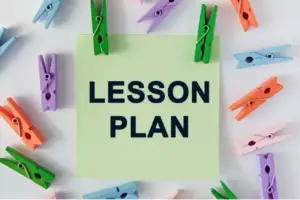This article contains information on Expanded Opportunities in Lesson Plan.

A lesson plan [3] is a teacher’s detailed description of the course of instruction for a lesson. A daily lesson plan is developed by a teacher to guide class learning. Details will vary depending on the preference of the teacher, subject being covered, and the needs of the students.
Lesson planning is a crucial aspect of effective teaching. A well-designed lesson plan provides a roadmap for teachers to deliver their lessons in a clear, organized, and engaging manner. An expanded lesson plan provides even more opportunities for teachers to enhance the learning experience for their students.
Expanded learning opportunities [1] basically create enriching experiences for students after-school and in the summer with activities that complement and support classroom-based instruction.
Examples of such programs include field trips, clubs, and tutoring programs. Such opportunities help students to build skills through hands-on, experiential learning. Furthermore, these types of opportunities provide students with diverse and engaging learning experiences that develop core social competencies that contribute to success in academics and beyond.
In this article, we will explore some of the expanded opportunities that can be incorporated into lesson plans.
Expanded Opportunities in Lesson Plan
1. Incorporating Technology
Technology has transformed the way we live, learn, and work. Teachers can leverage the power of technology to enhance their lesson plans. For instance, they can use multimedia tools, such as videos, animations, and interactive whiteboards, to engage students and improve their learning. Teachers can also use online resources, such as educational websites, virtual field trips, and educational games, to make the lessons more relatable and provide students with additional learning opportunities.
2. Differentiated Instruction
Every student is unique and has their own learning style, interests, and abilities. Teachers can use differentiated instruction strategies to meet the various needs of students. For example, teachers can use flexible grouping, and learning centers to provide students with different learning opportunities based on their individual needs and strengths.
3. Collaborative Learning
Collaborative learning involves students working together in groups to achieve a common goal. This strategy can promote social skills, critical thinking, problem-solving, and creativity. Teachers can incorporate collaborative learning into their lesson plans by designing group projects, group discussions, and peer evaluations.
4. Inquiry-based Learning

Inquiry-based learning is a student-centered approach that encourages students to ask questions, investigate, and discover knowledge on their own. Teachers can design lesson plans that incorporate inquiry-based learning by asking open-ended questions, encouraging students to explore their own interests, and providing opportunities for independent research.
5. Real-world Connections
Teachers can design lesson plans that connect the content they are teaching to real-world applications. For example, they can use case studies, and role-playing activities to illustrate how the concepts they are teaching can be applied in real-life situations. This can help students see the relevance and practical applications of what they are learning.
Problem solving teaching strategy works perfectly.
6. Assessment for Learning
Assessment for learning involves using assessment strategies to improve student learning. Teachers can use assessments, such as quizzes, self-reflection, and peer evaluations, to monitor student progress and provide timely feedback. This can help students identify their strengths and weaknesses and make necessary adjustments to improve their learning.
Practical Example of Expanded Opportunities in Lesson Plan
Subject: Social Studies
This lesson plan is designed to provide students with an understanding of expanded opportunities throughout history.
It aims to explore the concept of expanded opportunities in different contexts, such as civil rights movements, gender equality, and technological advancements.
Students will engage in various activities, discussions, and research to develop critical and analytical thinking skills and gain a broader perspective on the topic.
Learning Objectives:
- Understand the concept of expanded opportunities and its significance in society.
- Examine the role of individuals and groups in advocating for expanded opportunities.
- Identify the challenges and obstacles faced by individuals striving for expanded opportunities.
- Evaluate the impact of technological advancements on expanding opportunities in the modern world.
Materials:
- Textbooks, articles, or online resources on civil rights movements, gender equality, and technological advancements.
- Chart paper and markers.
- Computers or tablets with internet access.
- Handouts with discussion questions.
- Projector or interactive whiteboard.
Procedure:
1. Introduction
- Begin the lesson by asking students to define the term “expanded opportunities.” Write their responses on the chart paper.
- Start a brief discussion around their definitions, encouraging students to share examples of situations where opportunities have been expanded.
2. Historical Perspectives
- Divide students into small groups and assign each group a specific civil rights movement e.g female circumcision, women’s suffrage movement, etc.
- In their groups, students will research their assigned movement, focusing on key events, influential individuals, and the impact on expanding opportunities for marginalized groups.
- Each group will create a visual presentation summarizing their findings, highlighting the challenges faced and the progress made.
- Allow time for each group to present their findings to the class, promoting discussion and questions.
3. Individual Research

- Ask students to choose an individual (historical or contemporary) who has played a significant role in advocating for expanded opportunities.
- Students will conduct independent research on their chosen individual, exploring their background, accomplishments, and the impact of their work.
- Encourage students to consider individuals from different fields, such as politics, science, arts, or technology.
- Provide resources and guidance to support their research process.
4. Group Discussion

Bring the class back together and facilitate a discussion on the role of individuals in advocating for expanded opportunities.
Use discussion questions like:
i. What qualities or characteristics do these individuals possess that make them effective advocates?
ii. How do their actions inspire change and expand opportunities for others?
iii. What challenges or obstacles did they face in their pursuit of expanded opportunities?
iv. Are there any contemporary individuals you consider advocates for expanded opportunities? Why?
5. Technological Advancements
- Introduce the concept of technological advancements and their impact on expanding opportunities.
- Discuss examples of how technology has created new possibilities in education, communication, employment, and social activism.
- Show short video clips or share case studies highlighting the role of technology in expanding opportunities.
- Engage students in a brainstorming session where they identify potential future technological advancements that could further expand opportunities.
6. Conclusion
- Summarize the main points discussed during the lesson and highlight the importance of expanded opportunities in creating a more inclusive society.
- Encourage students to reflect on how they can contribute to expanding opportunities for others in their own lives.
- Assign a short written reflection where students express their thoughts on the lesson and propose actions they can take to promote expanded opportunities
Importance of Lesson Plan
Effective lesson planning is of great importance [2] to successful learning outcomes for students in the following ways:
1. Helps students and teachers understand the goals of an instructional module.
2. Enables the teacher to thoughtfully address individual learning needs among students.
3. Allows the teacher to translate the curriculum into learning activities.
4. Aligns the instructional materials with the assessment.
5. Aligns the assessment with the learning goal.
Conclusion
In conclusion, expanded opportunities in lesson plans can provide teachers with a variety of strategies to engage students, enhance their learning experience, and promote their academic success. By incorporating technology, differentiated instruction, collaborative learning, inquiry-based learning, real-world connections, and assessment for learning, teachers can design lesson plans that are both effective and enjoyable for their students.
References
[1] Chafee, Governor Lincoln D. “Expanded Learning Opportunities Are Key to Student Learning.” Expandinglearning.org, https://www.expandinglearning.org/expandingminds/article/expanded-learning-opportunities-are-key-student-learning.
[2] Jan, 28. “The Importance of Lesson Planning for Student Success.” William & Mary Education, School of Education, William & Mary, https://counseling.education.wm.edu/blog/the-importance-of-lesson-planning-for-student-success.
[3] Wikipedia contributors. “Lesson Plan.” Wikipedia, The Free Encyclopedia, https://en.m.wikipedia.org/wiki/Lesson_plan.
Don’t miss out on current updates, kindly like us on Facebook & follow us on Follow @EAfinder OR leave a comment below for further inquiries.






